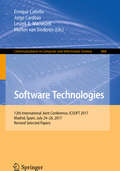 Software Technologies: 12th International Joint Conference, ICSOFT 2017, Madrid, Spain, July 24–26, 2017, Revised Selected Papers (Communications in Computer and Information Science #868)
2118474
Software Technologies: 12th International Joint Conference, ICSOFT 2017, Madrid, Spain, July 24–26, 2017, Revised Selected Papers (Communications in Computer and Information Science #868)
2118474
|
Marten Van Sinderen
Leszek A. Maciaszek
Jorge Cardoso
Enrique Cabello
|
9783319936413 |
2018 |
Contains images
|
|
 Software Technologies: 13th International Conference, ICSOFT 2018, Porto, Portugal, July 26-28, 2018, Revised Selected Papers (Communications in Computer and Information Science #1077)
2768680
Software Technologies: 13th International Conference, ICSOFT 2018, Porto, Portugal, July 26-28, 2018, Revised Selected Papers (Communications in Computer and Information Science #1077)
2768680
|
Marten Van Sinderen
Leszek A. Maciaszek
|
9783030291570 |
2019 |
Contains images
|
|
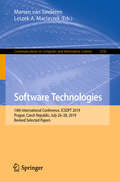 Software Technologies: 14th International Conference, ICSOFT 2019, Prague, Czech Republic, July 26–28, 2019, Revised Selected Papers (Communications in Computer and Information Science #1250)
3548310
Software Technologies: 14th International Conference, ICSOFT 2019, Prague, Czech Republic, July 26–28, 2019, Revised Selected Papers (Communications in Computer and Information Science #1250)
3548310
|
Marten Van Sinderen
Leszek A. Maciaszek
|
9783030529918 |
2020 |
Contains images
|
|
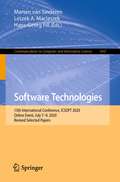 Software Technologies: 15th International Conference, ICSOFT 2020, Online Event, July 7–9, 2020, Revised Selected Papers (Communications in Computer and Information Science #1447)
4168578
Software Technologies: 15th International Conference, ICSOFT 2020, Online Event, July 7–9, 2020, Revised Selected Papers (Communications in Computer and Information Science #1447)
4168578
|
Marten Van Sinderen
Leszek A. Maciaszek
Hans-Georg Fill
|
9783030830076 |
2021 |
Contains images
|
|
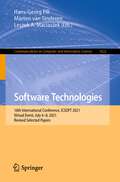 Software Technologies: 16th International Conference, ICSOFT 2021, Virtual Event, July 6–8, 2021, Revised Selected Papers (Communications in Computer and Information Science #1622)
4684963
Software Technologies: 16th International Conference, ICSOFT 2021, Virtual Event, July 6–8, 2021, Revised Selected Papers (Communications in Computer and Information Science #1622)
4684963
|
Marten Van Sinderen
Leszek A. Maciaszek
Hans-Georg Fill
|
9783031115134 |
2022 |
Contains images
|
|
 Software Technologies: 17th International Conference, ICSOFT 2022, Lisbon, Portugal, July 11–13, 2022, Revised Selected Papers (Communications in Computer and Information Science #1859)
5416704
Software Technologies: 17th International Conference, ICSOFT 2022, Lisbon, Portugal, July 11–13, 2022, Revised Selected Papers (Communications in Computer and Information Science #1859)
5416704
|
Marten Van Sinderen
Leszek A. Maciaszek
Hans-Georg Fill
|
9783031372315 |
2023 |
Contains images
|
|
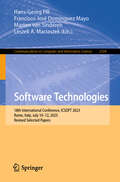 Software Technologies: 18th International Conference, ICSOFT 2023, Rome, Italy, July 10–12, 2023, Revised Selected Papers (Communications in Computer and Information Science #2104)
6351745
Software Technologies: 18th International Conference, ICSOFT 2023, Rome, Italy, July 10–12, 2023, Revised Selected Papers (Communications in Computer and Information Science #2104)
6351745
|
Marten Van Sinderen
Leszek A. Maciaszek
Hans-Georg Fill
Francisco José Domínguez Mayo
|
9783031617539 |
2024 |
Contains images
|
|
 Software Technologies: 8th International Joint Conference, ICSOFT 2013, Reykjavik, Iceland, July 29-31, 2013, Revised Selected Papers (Communications in Computer and Information Science #457)
5787055
Software Technologies: 8th International Joint Conference, ICSOFT 2013, Reykjavik, Iceland, July 29-31, 2013, Revised Selected Papers (Communications in Computer and Information Science #457)
5787055
|
José Cordeiro and Marten van Sinderen
|
9783662449202 |
2014 |
Contains images
|
|
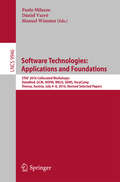 Software Technologies: Applications and Foundations
1532824
Software Technologies: Applications and Foundations
1532824
|
Manuel Wimmer
Paolo Milazzo
Dániel Varró
|
9783319502304 |
2016 |
Contains images
|
|
 Software Technologies: STAF 2018 Collocated Workshops, Toulouse, France, June 25-29, 2018, Revised Selected Papers (Lecture Notes in Computer Science #11176)
2333576
Software Technologies: STAF 2018 Collocated Workshops, Toulouse, France, June 25-29, 2018, Revised Selected Papers (Lecture Notes in Computer Science #11176)
2333576
|
Manuel Mazzara
Iulian Ober
Gwen Salaün
|
9783030047719 |
2018 |
Contains images
|
|
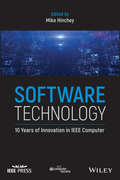 Software Technology: 10 Years of Innovation in IEEE Computer
2096558
Software Technology: 10 Years of Innovation in IEEE Computer
2096558
|
Mike Hinchey
|
9781119174233 |
2018 |
Contains images
|
|
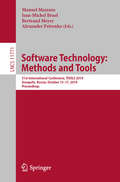 Software Technology: 51st International Conference, TOOLS 2019, Innopolis, Russia, October 15–17, 2019, Proceedings (Lecture Notes in Computer Science #11771)
2957423
Software Technology: 51st International Conference, TOOLS 2019, Innopolis, Russia, October 15–17, 2019, Proceedings (Lecture Notes in Computer Science #11771)
2957423
|
Bertrand Meyer
Manuel Mazzara
Jean-Michel Bruel
Alexander Petrenko
|
9783030298524 |
2019 |
Contains images
|
|
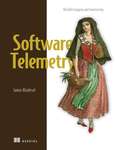 Software Telemetry: Reliable logging and monitoring
4250273
Software Telemetry: Reliable logging and monitoring
4250273
|
Jamie Riedesel
|
9781638356479 |
2021 |
Contains images
|
|
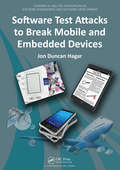 Software Test Attacks to Break Mobile and Embedded Devices: Software Test Attacks To Break Mobile And Embedded Devices (Chapman And Hall/crc Innovations In Software Engineering And Software Development Ser. #6)
2712776
Software Test Attacks to Break Mobile and Embedded Devices: Software Test Attacks To Break Mobile And Embedded Devices (Chapman And Hall/crc Innovations In Software Engineering And Software Development Ser. #6)
2712776
|
Jon Duncan Hagar
|
9781498760140 |
2014 |
Contains images
|
|
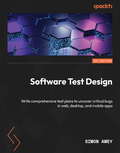 Software Test Design: Write comprehensive test plans to uncover critical bugs in web, desktop, and mobile apps
5030522
Software Test Design: Write comprehensive test plans to uncover critical bugs in web, desktop, and mobile apps
5030522
|
Simon Amey
|
9781804614730 |
2022 |
Contains images
|
|
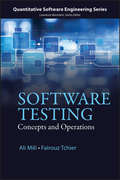 Software Testing
1049081
Software Testing
1049081
|
Fairouz Tchier
Ali Mili
|
9781119065593 |
2015 |
Contains images
|
|
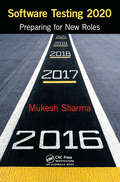 Software Testing 2020: Preparing for New Roles
5569479
Software Testing 2020: Preparing for New Roles
5569479
|
Mukesh Sharma
|
9781315349176 |
2017 |
Contains images
|
|
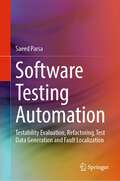 Software Testing Automation: Testability Evaluation, Refactoring, Test Data Generation and Fault Localization
5261766
Software Testing Automation: Testability Evaluation, Refactoring, Test Data Generation and Fault Localization
5261766
|
Saeed Parsa
|
9783031220579 |
2023 |
Contains images
|
|
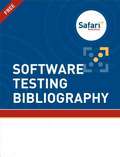 Software Testing Bibliography
837610
Software Testing Bibliography
837610
|
Safari Content Team
|
9781457180149 |
2013 |
Contains images
|
|
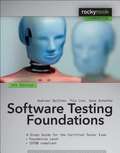 Software Testing Foundations
875996
Software Testing Foundations
875996
|
Andreas Spillner
Tilo Linz
Hans Schaefer
|
9781492001485 |
2002 |
Contains images
|
|
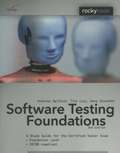 Software Testing Foundations: A Study Guide for the Certified Tester Exam (2nd edition)
44042
Software Testing Foundations: A Study Guide for the Certified Tester Exam (2nd edition)
44042
|
Andreas Spillner
Tilo Linz
Hans Schaefer
|
9781933952086 |
2007 |
|
|
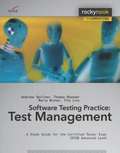 Software Testing Practice: Test Management
553336
Software Testing Practice: Test Management
553336
|
Andreas Spillner
Tilo Linz
Thomas Rossner
Mario Winter
|
9781457118227 |
2007 |
Contains images
|
|
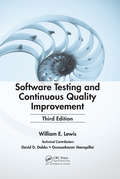 Software Testing and Continuous Quality Improvement
3877417
Software Testing and Continuous Quality Improvement
3877417
|
William E. Lewis
|
9781351722209 |
2008 |
Contains images
|
|
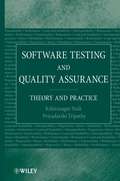 Software Testing and Quality Assurance
1693320
Software Testing and Quality Assurance
1693320
|
Kshirasagar Naik
Priyadarshi Tripathy
|
9781118211632 |
2008 |
Contains images
|
|
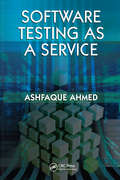 Software Testing as a Service
6269868
Software Testing as a Service
6269868
|
Ashfaque Ahmed
|
9781040182321 |
2010 |
Contains images
|
|